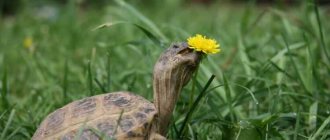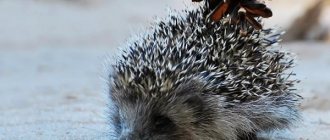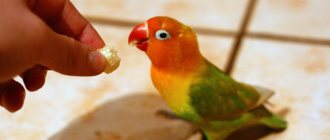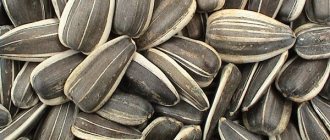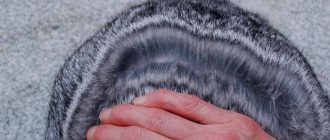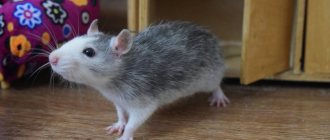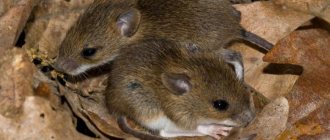Aquatic ornamental turtles are frequent inhabitants of home aquariums. These cute reptiles are loved by children and adults alike. In order for a turtle to live a long and fulfilling life in a closed tank, you need to create appropriate living conditions for it and pay special attention to the correct diet.
In the article we will look at popular brands of complete food and treats for aquatic turtles, how many times a day, at what time and how to feed them correctly, whether turtles need mineral and vitamin supplements, differences in the diet of adult and small pets, and also depending on the species turtles.
Features of feeding aquatic turtles
Aquatic turtles eat plant and animal foods. During the period of growth and formation of the body, turtles need food rich in protein. You can add natural products to your diet in combination with ready-made dry food designed specifically for aquatic turtles.
Natural products are served to turtles in small pieces. A single portion is determined so that in a 30-minute snack the turtle can completely eat the entire piece of food served. Young reptiles usually need 2-3 pieces of 1 cm3 in size, and for feeding adult turtles the size of the pieces should be slightly increased. If after a snack there is an uneaten piece left in the aquarium, you can reduce the portion at the next feeding.
A few more important rules for feeding aquatic turtles:
- natural food should be thermally processed before feeding the reptile;
- food served must be at room temperature;
- food can be placed in the aquarium in a special feeder located on dry land so as not to pollute the water;
- Feeding pieces of food from tweezers is allowed;
- To create a balanced diet, it is allowed to combine ready-made food with natural food.
What do turtles eat in the wild?
The main component of the diet of red-eared turtles in the wild are shellfish: mussels and snails, oysters, and crustaceans. They have no teeth, but this does not prevent them from excellently dealing with mollusk shells: with strong jaws they break them and eat the pulp.
In the summer, insects become food for turtles: grasshoppers, beetles, etc.
They are very fond of algae, plankton and small fish. They also eat tadpoles, fish fry and frogs.
Review of artificial food for aquatic turtles
It is recommended to use dry food not as the main food for aquatic turtles, but as an additional feed that goes well with natural food.
The range of dry food for aquatic turtles includes a large selection of products from different global manufacturers. Let's take a brief overview of the types of artificial food and other healthy treats for pet reptiles.
Complete dry food
Complete dry food can be given to baby and adult turtles every day. This product contains useful components of plant and animal origin, selected taking into account all the requirements of the reptile’s body.
Popular brands:
- Sera;
- "Zooworld";
- Tetra ReptoMin;
- Dajana.
Treats
The “Treats” category includes non-complete foods. They can only be given to adult turtles and no more than once a week.
Popular food treats:
- JBL Tortil;
- Tetra ReptoDelica Snack;
- Sera Raffy Royal;
- Zoomir "Tortilla M" Strong shell, etc.
Vitamin and mineral complexes
At home, turtles cannot receive all the microelements necessary for their body, which they obtain in the natural environment. To ensure that the reptile does not get sick and feels good, it needs to be periodically fed with special vitamin and mineral supplements. You can buy ready-made complexes in pet supply stores.
Vitamin and mineral supplements for turtles:
- MIX – mineral supplement with calcium;
- MIX – general strengthening supplement;
- mineral block "Tortilla";
- Beaphar Turtle Vitamin – vitamin complex;
- FIORY Tarta Vigor – feed additive with vitamins;
- mineral block Ca+D3 “Tortilla M”;
- Sera vitamins;
- Dajana is a mineral stone for aquatic turtles.
Basic feeding rules
To properly feed a red-eared turtle, you must comply with the basic conditions and some subtleties:
- Any food needs to be cut into pieces: the smaller the turtle, the smaller the pieces.
Any food needs to be cut into pieces
- Aquatic reptiles tear large pieces with their sharp claws, so that plant food can be fed whole.
- Before serving, products must be washed, seeds and peels removed.
- The pet should eat the food within 30 minutes. The serving size should be calculated based on this indicator, and should not exceed half the size of the shell. You can also give pieces of food the size of the reptile's head.
- Feed should be given at room temperature. Very cold food is harmful to your pet's health.
- Turtles search for food using their vision. The more attractive the color of the food, the faster she will find and eat it. For this you can use carrots and tomatoes.
- It is better to feed your pet in the morning, but it is not essential. It is important that she has time to digest what she eats during daylight hours or with the lamp on.
- Uneaten food must be immediately removed from the reservoir - this way the reptile will develop the habit of eating at certain hours.
There are different ways to feed armored animals: with tweezers, from a special bowl, or by throwing them into water.
You can feed red-eared turtles with tweezers
It is best to feed the red ear in another aquarium or basin, because leftover food will contaminate the terrarium, and the water will have to be replaced frequently.
You can also teach him to eat on an island equipped in the aquarium. First, food is placed at the very edge of the shore near the water. If the reptile is hungry, it will have to take food. So gradually get used to eating from a small saucer with water.
You should not hand feed your reptile too often to avoid getting used to this method of feeding and refusing to eat differently. There is also a risk of being bitten.
You cannot distract your pet while eating: sudden movements and loud sounds frighten him.
Diet of an adult turtle and small pets
The diet of an aquatic turtle should be combined - natural food combined with artificial food. Let's look at what foods can and cannot be given to aquarium reptiles.
Useful and harmful natural products for aquatic turtles:
- You can give low-fat river fish in crushed form with chopped bones. You should not feed turtles bony and fatty fish.
- You can feed live gammarus and small crustaceans.
- Shrimp and crabs are allowed to be fed raw.
- You should not feed turtles squid, although they love them very much.
- It is strictly forbidden to give reptiles the meat of terrestrial animals and factory-made meat products (sausage, canned food, etc.). The digestive system of reptiles does not digest such food.
- Occasionally you can treat your turtle to pieces of beef heart and liver. These foods provide the body with vitamin A.
- It is allowed to feed the reptile with food mice and frogs.
- From natural plant foods, turtles can be given carrots, lettuce, apple pulp, greens, sprouted oats and barley.
- Non-poisonous meadow plants, as well as algae and some types of aquatic plants can be introduced into the diet.
- Pieces of pear, watermelon, melon, banana, apricot and raspberry are served in limited quantities.
- You cannot give turtles citrus fruits, nuts, soybeans, beans, cabbage, bread, flour products, cereals, fish waste, dairy products, and chicken eggs.
- Foods high in phosphorus, strumogenic substances and oxalates are harmful to reptiles.
- With pleasure and benefit, turtles eat various insects and larvae living in the water. They can be fed barnacles, bloodworms, locusts, crickets, fly larvae, earthworms and moths. The insect must first be decapitated. Can be given dried, frozen, or live.
- Live and thawed mollusks, land snails, ampularia, marises, etc. are well absorbed by the reptile body. But it is better not to treat the turtle to slugs without shells.
HERBIVORES (land turtles - Central Asian, Mediterranean)
Main food
almost any plants, vegetables, fruits and berries that are non-toxic to turtles - dandelions, carrots, apples, lettuce, tomatoes, cucumbers, pears, bananas. 80% of the entire diet should be greens - a variety of salads, leaves, edible flowers. Vegetables and fruits should be given much less often than salads, especially for fruits.
Additional food
Plants - tradescantia, clover, plantain, sorrel (a little), thistle leaves, dandelions, lawn grass, gooseberry, alfalfa, vetch, timothy, china, sprouted oats, barley, pea stems and leaves.
Vegetables - lettuce, carrot tops, carrots, cucumbers (a little), tomatoes, peppers, beets, beans, pumpkin, artichoke, green onions, radishes, zucchini, eggplant, horseradish (a little),
Fruits - apples, plums (cut), peaches (cut), apricots (cut), melon, mango, bananas, oranges, tangerines.
Berries - strawberries, raspberries, blueberries, blueberries, wild strawberries, blackberries, watermelon
Additionally (a little) - non-poisonous mushrooms (russula, champignons, boletus), balanced dry food for land turtles (Sera, Tetra, Wardley), bran, soybean meal, dry yeast, dry seaweed, young sunflower seeds (raw).
Specifics of the turtle menu depending on their species
Waterfowl turtles are often predators, so the basis of their diet is food of animal origin. If your aquarium contains a semi-aquatic or swamp reptile that prefers vegetarian food, the diet will be based on plant foods. In any case, the nutrition for a turtle must be balanced and varied so that the body of the domestic reptile fully receives all the necessary substances and microelements.
Features of the diet of turtles of different species:
- The red-eared turtle prefers fry, small fish with bones, insect larvae, chicken fillets, gammarus and shrimp. From plant foods you can give apples, lettuce and fresh cucumber slices.
- The amphibious turtle Trionics Chinese gladly eats beef liver, heart, lean fish, fry and small frogs. From plant foods, she will like fresh herbs and tomato slices.
- The European marsh turtle loves lean meat, fish with small bones and plant foods.
- The musk turtle prefers to eat algae, fish and aquatic insects.
Not all turtles are the same
Turtles belong to the class of reptiles, or reptiles (although here, given the presence of a hard, inflexible shell, this name does not seem entirely appropriate). These are ancient animals that arose more than 200 million years ago. The most important difference between turtles and other reptiles is the presence of a protective cover, a shell that protects the animal from external threats.
All turtles are not only divided into 2 large categories: land and sea. In addition, they differ in size and habitat. There are 2 main suborders, divided according to the type of way they hide their heads in their shell :
- cryptocervical - place the head inside the shell in the shape of the letter S;
- side-necked - hide the head towards the side paw.
Based on habitat they are divided into:
- marine - live in bodies of salt water;
- terrestrial - live either on land or in fresh waters.
Accordingly, terrestrials are divided into land and freshwater.
In total there are more than 300 species, which form about 14 families.
Learn more about trionics and vulture turtles.
Based on size , land turtles are divided into:
- large ones - the elephant tortoise (Galapagos), reaching a length of 2 meters and a weight of 400 kg; leopard (panther) tortoise - 1 meter in height and 50 kg in weight; Seychelles giant tortoise - 1 meter in length and up to 120 kg in weight, etc.;
- small ones - Cape speckled (the smallest in the world), reaching 10 cm in length and weighing a maximum of 200 g; Central Asian - height up to 20 cm, weight up to 10 kg; Egyptian turtle - up to 10 cm in length, weight up to 6 kg, etc.
Freshwater ones are:
- medium - caiman species (length up to 1 meter, weight up to 30 kg), red-eared (up to 40 cm in length, weight up to 20 kg), European swamp (40 cm in length and weight up to 15 kg);
- small ones - painted turtle (up to 15 cm in length, weight up to 4 kg), black marsh turtle (up to 18 cm in length, weight up to 4 kg), Cagliz card (length up to 18 cm, weight up to 3 kg), etc.
Marine ones are also divided into large and small - in total there are more than 70 species.
Did you know? Modern research debunks the myth about the slowness of turtles: it has been proven that marine species can move at speeds of up to 40 km/h - considering their size, this is quite a high speed. The speed of movement directly depends on the weight of the shell: the heavier it is, the slower the animal moves.
By type of food they are divided into:
- carnivorous (they need up to 90% of food of animal origin) - this includes almost all aquatic animals (especially young ones); it is noteworthy that with age, predatory individuals can become omnivores;
- omnivores (50% plants and 50% animal food) - both land and sea;
- herbivores - (up to 90% plant food) - some types of land turtles.
How often and at what time to feed turtles
It is recommended to feed your turtle at the same time. For the first three years of life, they are fed once a day, mainly with food of animal origin. As they grow, the need for such food is lost, so plant foods and dry food become the main part of the diet.
Adult turtles are fed once every 2-3 days. In summer, turtles eat more often, but in small portions, and in winter they may not eat for several days, and then happily consume an increased portion. During the cold season, it is recommended to supplement the turtle’s diet with vitamin and mineral supplements.
After feeding the turtle, any remaining food is removed from the aquarium. At subsequent feedings, fresh food is supplied. You should not feed your reptile spoiled foods, as they can cause poisoning to the body.
Do turtles drink water?
The structure of the turtle's head and larynx is such that it is difficult for it to drink water: the water it drinks is immediately poured out through the nostrils. Under natural conditions, some species of turtles can survive without water; There are also those who use it in small quantities. Turtles consume their main liquid from food or through the skin (during water procedures). A turtle can drink water as such only in case of severe dehydration.
Thus, when setting up a terrarium or aquarium for a turtle, you should not attach a standard drinking bowl - the animal will not use it for its intended purpose, it can interfere and irritate the turtle. To provide it with sufficient water balance in the body, you need to choose the right diet - more juicy vegetables, fresh grass, fruits (if it is a tropical species). Young dandelion and clover leaves are 85% water - thus, by eating them, the turtle will receive enough moisture.
Read on for tips on caring for your aquarium (how to start your aquarium for the first time, choosing a filter and clearing algae from your aquarium; what you need to know about water hardness), as well as the ten best plants for your aquarium.
Handling babies
When a small turtle appears in an aquarium, it should be surrounded with maximum care and attention. If you don't pay attention to this delicate creature, it can die.
There are several recommendations on how to care for a small red-eared turtle:
- It is not recommended to pick up babies. Stressful situations for them can result in illness and death.
- Do not stand over the aquarium or knock on its glass.
- The aquarium should not be left in direct sunlight or in a draft.
- The water temperature for babies should be 26-27 °C, the air temperature - 32 °C.
- The water needs to be changed every two days.
- It is necessary to saturate the turtle’s body with calcium.
- Children and adults cannot be kept together.
It must be remembered that many possible health problems in red-eared sliders can be avoided. If you follow the recommendations, this beautiful creature will delight its owner for decades.
What kind of fish is best to feed a small red-eared turtle?
As already mentioned, fish should be lean. This could be pollock, blue whiting, hake, cod, navaga, perch and carp. Give the fish finely chopped and with small bones. For large fish, remove the rib bones. Should I feed my reptiles raw or cooked fish? Here experts have not come to a consensus. Some believe that fish should only be raw, others insist that it should be boiled. In our opinion, there is no need to boil fish. It is enough to pour boiling water over it.
It is recommended to add bone meal (available at a pet store) or crushed eggshells to your red-eared food twice a week.
Plant food
In order to properly maintain reptiles, it is worth including in the menu not only animal food, but also plant food mixtures. Plants can be fed to young and adult individuals, and with age the amount of this food should increase.
When keeping a turtle in an aquarium, the menu must include the following herbal components:
- Various types of grass. Amphibians should be fed plantain, clover, leaves and flowers from dandelions, and rhubarb. Turtles are especially fond of coltsfoot leaves, sprouted grains of oats and barley;
- Reptiles will happily eat plums, banana pulp, pear slices, juicy pitted peaches, mangoes; it is advisable to cut all these fruits into small pieces. You can also give orange, tangerine, pieces of melon pulp;
- Freshwater animals can eat aquarium vegetation. In the aquarium you can plant duckweed, spirogyra, water beetle, and pond algae;
- Vegetables must be included in the menu. The most favorite vegetables include bell peppers, cucumbers, tomatoes, eggplants, zucchini, pumpkin, radishes, celery, legumes, carrot roots, and beets. But white cabbage and other varieties of this vegetable should not be given;
- Once every 7 days, the turtle can be given pieces of mushrooms such as boletus, champignons, and russula.
Important! Is it possible to give reptiles food from the human table (bread, cheese, cottage cheese, sausage, cereals and others)? In no case, it can negatively affect the functioning of the digestive system. Also avoid feeding pet food, citrus peels, and berries with seeds.
Basic rules for bringing pet turtles out of hibernation
For 3-4 months it hibernated indoors at a temperature of +6-10C; during the period of hibernation or hibernation, the pet lost about 10% of its weight. By the time the reptile leaves the hibernation, the reptile’s body is exhausted, therefore, in order to safely wake up the red-eared or Central Asian turtle, it is necessary to carry out the following steps step by step.
Smooth increase in temperature
In the wild, reptiles wake up when the air temperature gradually rises; the same principle applies in March, when it is necessary to bring the turtle out of hibernation. Within a week, it is necessary to bring the temperature in the terrarium to +20C, and then 3-4 days later to 30-32C. This process is done gradually; the container with the sleeping reptile is first transferred to a place with a temperature of 12C, then 15C, 18C, etc. You cannot place a sleepy turtle in a terrarium with a temperature of +32C, such a sharp drop will instantly kill the pet.
Taking baths
The body of an exotic animal is severely exhausted after a long hibernation; in order to completely awaken a land turtle, it is recommended that the awakened reptile take baths lasting 20-30 minutes in warm water with glucose. Water will saturate the animal’s body with life-giving moisture, the animal will remove urine, and hygiene procedures will raise the overall tone of the body. After bathing, the pet must be immediately placed in a warm terrarium, excluding the possibility of drafts.
In order to bring the red-eared turtle out of hibernation, after the stage of raising the temperature in the aquaterrarium, it is recommended to bathe the animal daily for 40-60 minutes in warm water for a week. It is strictly forbidden to fill an aquarium full of water with a sleepy reptile, which may choke and die.
A course of restorative drugs
After waking up, the body of an exhausted turtle is susceptible to various infections, viruses and pathogenic fungi. During hibernation, the animal lost a huge amount of energy and moisture, therefore, in order to bring a land turtle or red-eared turtle out of hibernation without complications, herpetologists prescribe the animal a course of vitamin preparations and electrolytic solutions. These measures are aimed at restoring the required amount of fluid and stimulating the reptile’s body’s defenses.
Ultraviolet irradiation
After waking up, aquatic and land turtles turn on a source of ultraviolet radiation for reptiles for 10-12 hours.
Feeding
If all actions to awaken the reptile are carried out smoothly and correctly, after 5-7 days from the moment it emerges from hibernation, the pet will begin to feed on its own.
The process of bringing a reptile out of hibernation does not always go smoothly; it is recommended to urgently consult a doctor in the following situations:
- after the temperature rises, the animal does not wake up;
- the pet does not pass urine;
- the turtle does not eat;
- the reptile's eyes do not open;
- The animal's tongue is bright red.
The most important thing for bringing a turtle out of hibernation is warmth, lighting and the patience of the owner. After proper awakening, reptiles continue to enjoy life and delight all family members.
Reproduction at home
When turtles live in their natural environment, they begin to reproduce only after reaching 6-8 years of age. When turtles are kept in an artificial environment, they are ready to reproduce at a maximum of 5 years of age. Under natural conditions, the reproduction process begins at the end of February and lasts until May. Having met a female, the male tries to position himself as close to the female’s head as possible.
When the time comes to lay eggs, the female leaves the pond and heads to land, where she begins to search for a suitable place. After this, she wets the soil with water, which she prudently stored in the anal bladders. Then the female begins to form a nest.
To do this, she uses her hind legs. As a result of the active actions of the turtle, a ball-shaped nest is formed, the diameter of which, depending on the type of turtle, can reach up to 7-25 cm.
The female lays from five to twenty eggs at a time, the diameter of which is up to 4 cm on average. After this process, the turtle covers them with soil. Turtles do not care about their future offspring and immediately climb back into the sea (into the water). Eggs develop at temperatures from +21 to +30 degrees for 3-5 months. When the development of eggs occurs at a temperature of +27 degrees and below, then males are born, and when at a temperature of about +30 degrees and above, females are born.
A crowd of red-eared turtles!
Watch this video on YouTube
